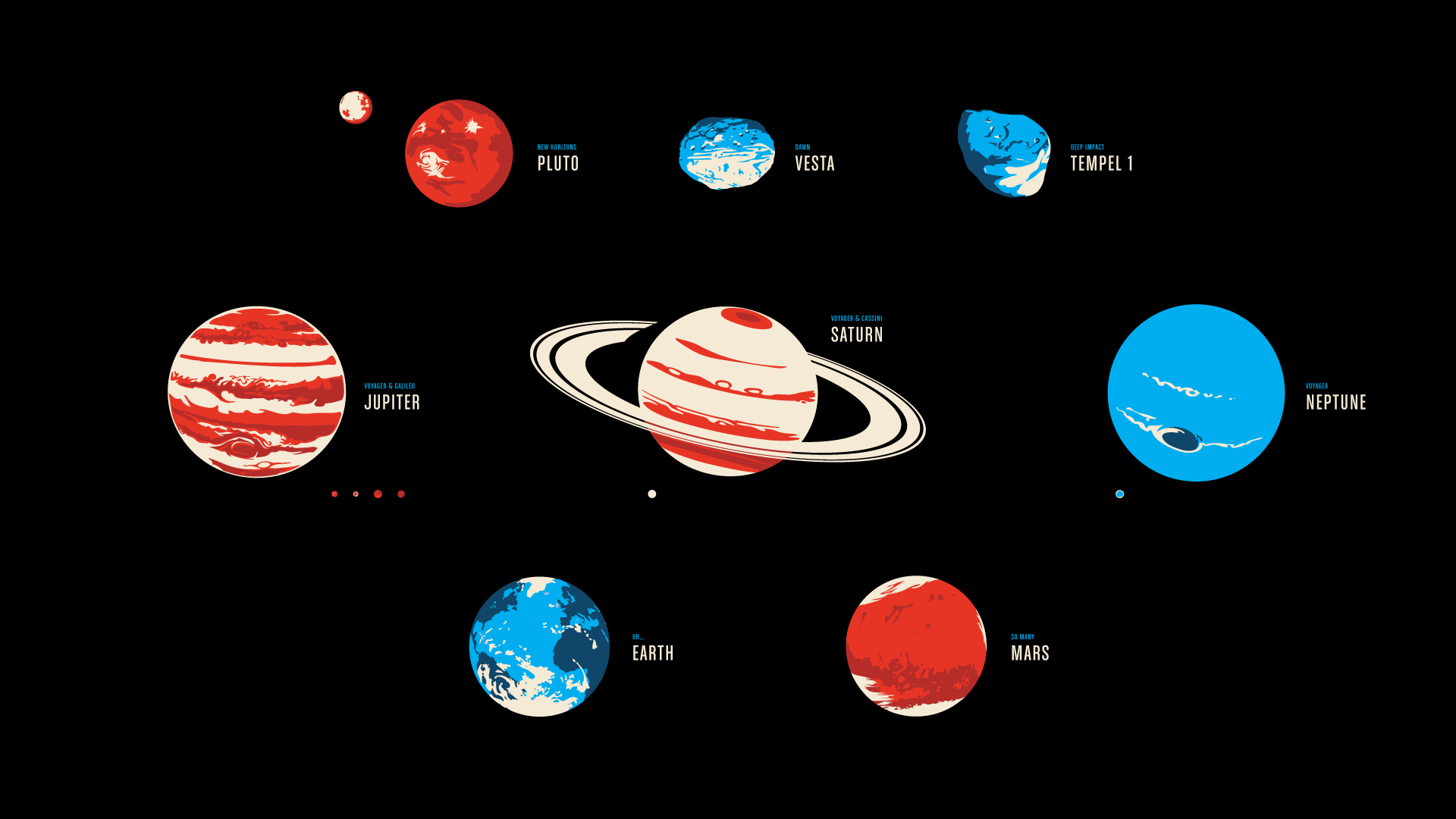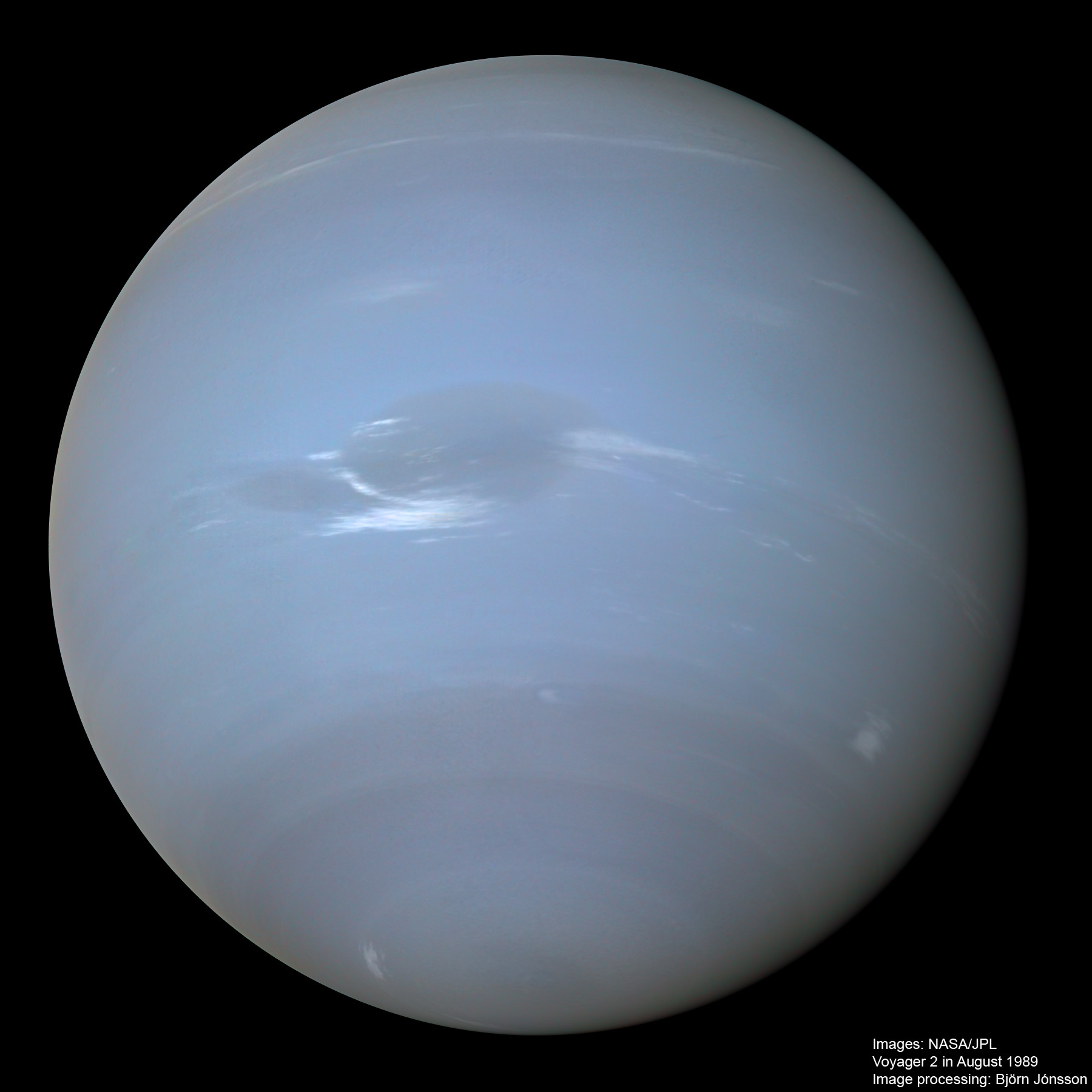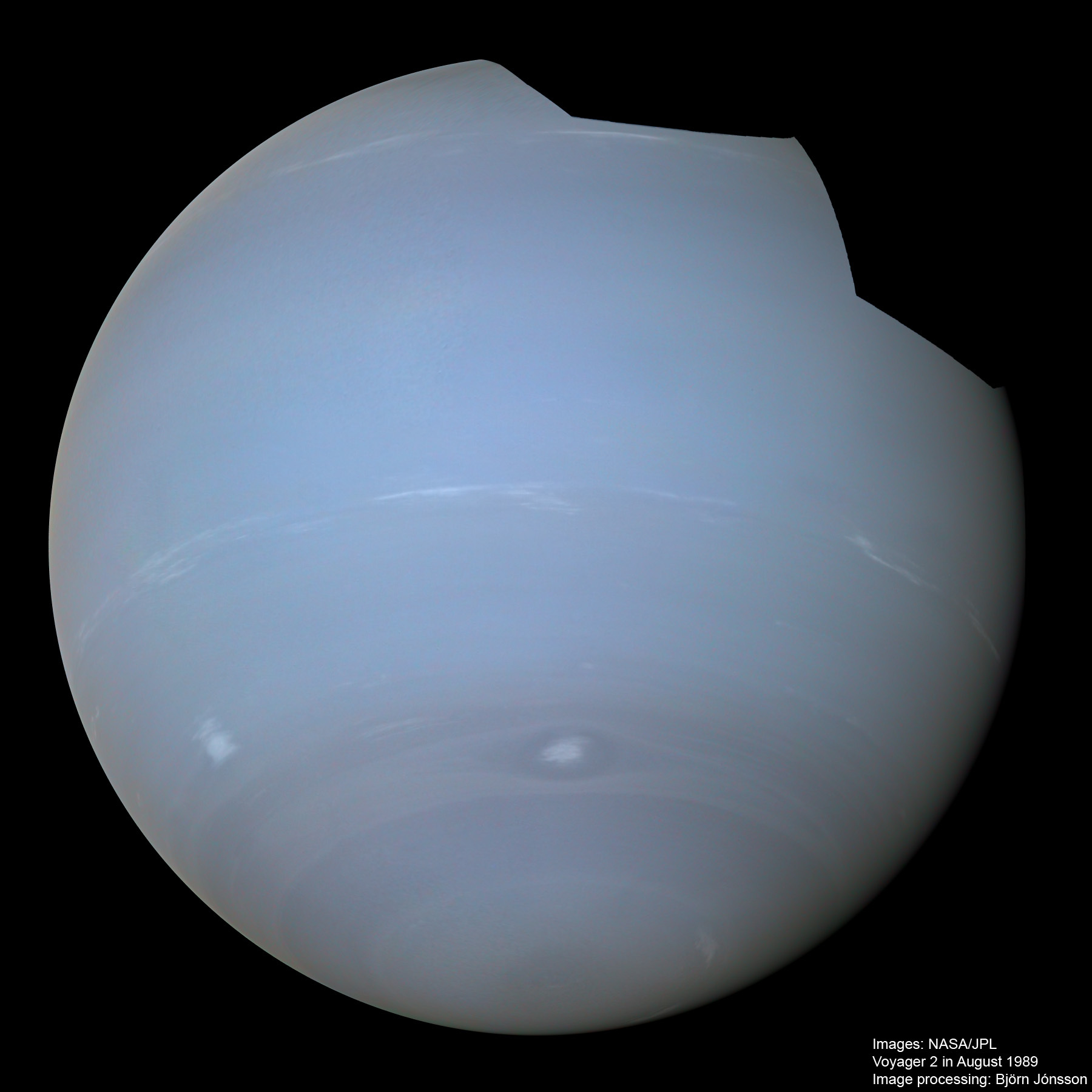Webb’s latest image is the clearest look at Neptune's rings in 30+ years, and our first time seeing them in infrared light. Take in Webb's ghostly, ethereal views of the planet and its dust bands, rings and moons: https://go.nasa.gov/3RXxoGq #IAC2022
Triton Image from Voyager Colored
Nice update to an old Voyager image with colors added based on actual colors captured in other images. See original post here by Jason Major.
Cyber Tuesday Spaceprobe Deal
 For two days only, buy one of our limited edition Robotic Spacecraft Series Prints and get the full suite of vinyl stickers for free. This is a total savings of $24 and would serve as a great stocking stuffer to follow the presentation of the print.
For two days only, buy one of our limited edition Robotic Spacecraft Series Prints and get the full suite of vinyl stickers for free. This is a total savings of $24 and would serve as a great stocking stuffer to follow the presentation of the print.
Historic Robotic Spacecraft Poster Survey
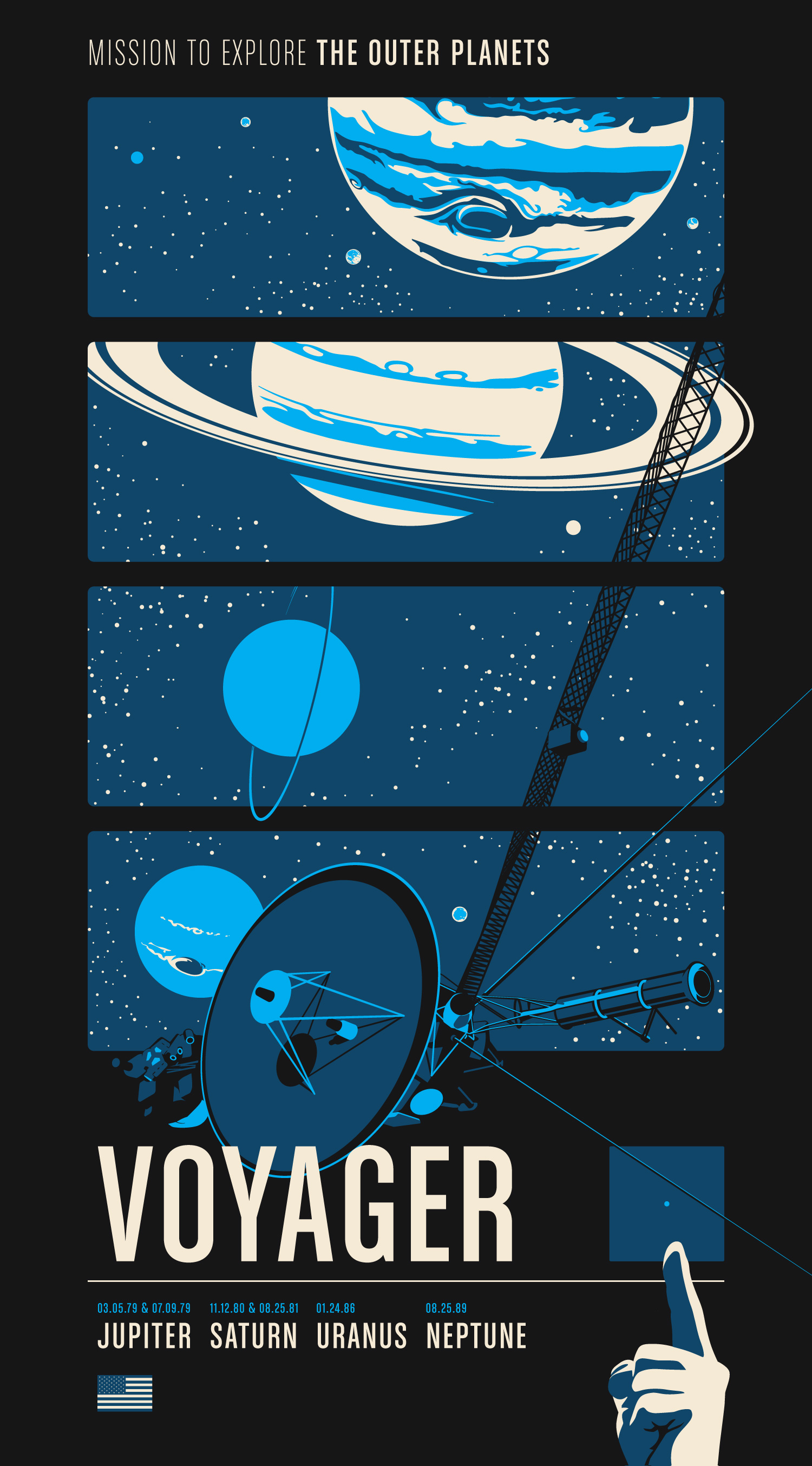 Our new Kickstarter project proposes the creation of three screen-printed posters celebrating the most popular and notable interplanetary robotic space missions in history. Going into this, we knew that poster #1 had to go to the hugely popular Voyager missions (shown above). However, we need your help selecting the themes of posters #2 and #3. So head over to The Planetary Society now to vote on your three favorite missions, but do it by the 19th to have it count for the poster selection. If this goes better than expected we could even wind up designing a fourth or fifth.
Our new Kickstarter project proposes the creation of three screen-printed posters celebrating the most popular and notable interplanetary robotic space missions in history. Going into this, we knew that poster #1 had to go to the hugely popular Voyager missions (shown above). However, we need your help selecting the themes of posters #2 and #3. So head over to The Planetary Society now to vote on your three favorite missions, but do it by the 19th to have it count for the poster selection. If this goes better than expected we could even wind up designing a fourth or fifth.
Kickstarter Project Coming Oct 2
New Full Disc Images of Neptune
New global mosaic Voyager 2 images of Neptune by Björn Jónsson.
Rolf Olsen Photo Renders Neptune
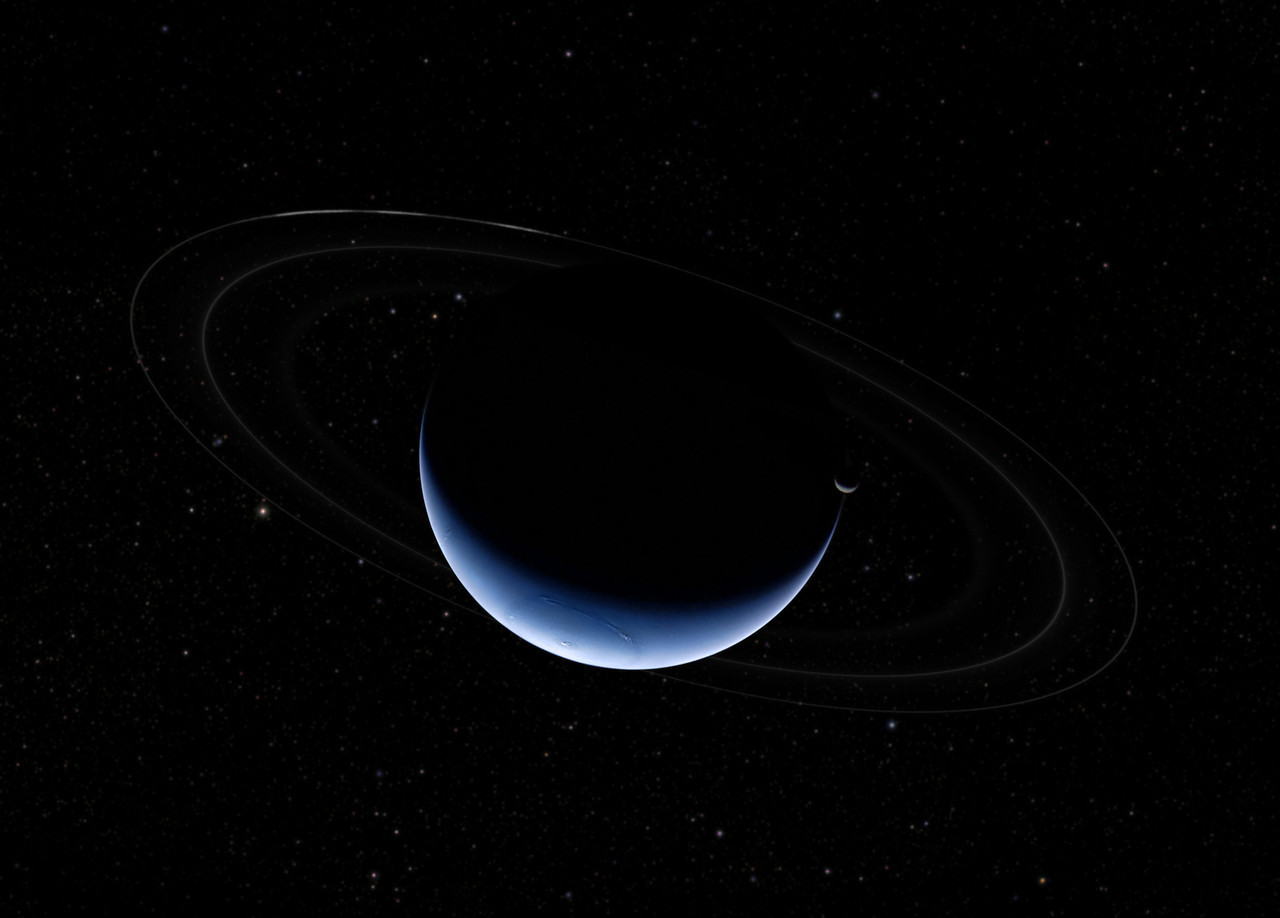 The above is an interesting project to image the full Neptune system based on actual data returned by Voyager. According to the article published along with the image — Rolf Wahl Olsen composed this scene from actual images from the departing Voyager probe. The rings (which were never photographed in their entirety) are based on over-exposed images and then density mapped to a model which was applied to the scene. Even the stars are based on one of the over exposed images of the rings which revealed what the probe would have seen and that field data was inserted from and image generated by Google Sky.
The above is an interesting project to image the full Neptune system based on actual data returned by Voyager. According to the article published along with the image — Rolf Wahl Olsen composed this scene from actual images from the departing Voyager probe. The rings (which were never photographed in their entirety) are based on over-exposed images and then density mapped to a model which was applied to the scene. Even the stars are based on one of the over exposed images of the rings which revealed what the probe would have seen and that field data was inserted from and image generated by Google Sky.
Moon May at Kurzgesagt
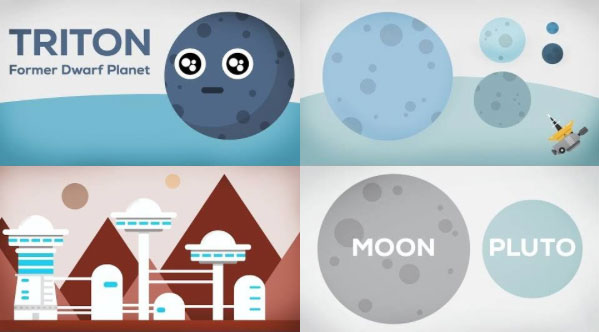 We mentioned these guys a week or so ago. But they just finished Moon May which is a series of animated videos that explore our moon, Mars’ moons, Neptune’s moon Triton and the Pluto system.
We mentioned these guys a week or so ago. But they just finished Moon May which is a series of animated videos that explore our moon, Mars’ moons, Neptune’s moon Triton and the Pluto system.
Check Out Kurzgesagt
Especially if you have kids with an appreciation for science. These guys regularly do great animations that explain complex science — appropriate for all ages. They also promise a series of cool videos about cool moons in our solar system. So far they have only covered our own, next up… Mars’ Deimos and Phobos.
Neptune Revisited
 Daniel Machácek does some modernizing of old Voyager 2 data at neptune. You can clearly see a shadow of one of Neptune’s moons at the top right edge and two others in the same area that are much less obvious. Interesting thing about data is that it is often better than the processing technology that happens to be available at the time the actual missions took place. Add to that the fact that there is a small army of talented freelance imagers like Daniel, the result is what feels like new images from old missions.
Daniel Machácek does some modernizing of old Voyager 2 data at neptune. You can clearly see a shadow of one of Neptune’s moons at the top right edge and two others in the same area that are much less obvious. Interesting thing about data is that it is often better than the processing technology that happens to be available at the time the actual missions took place. Add to that the fact that there is a small army of talented freelance imagers like Daniel, the result is what feels like new images from old missions.
You Are the Center of the Solar System
 You Are The Sun is the latest space themed tee by Chop Shop Store. Following on iconic tees that collected various deep space missions and historic Earth orbit missions, this new design draws a new picture of The Solar System as we know it today, complete with Carl Sagan’s pale blue dot.
You Are The Sun is the latest space themed tee by Chop Shop Store. Following on iconic tees that collected various deep space missions and historic Earth orbit missions, this new design draws a new picture of The Solar System as we know it today, complete with Carl Sagan’s pale blue dot.

With your head as a stand-in for The Sun — the tee includes all 8 planets, 7 major moons, The Asteroid Belt and even details little Pluto lost among countless Kuiper Belt objects. We are now providing yet another link here to get it for Men on American Apparel 2001 or Tultex tees and for Women on American Apparel 2102 tees.
50 Years of Space Exploration Map
 This is so nice, but I am furious that I didn’t get to design this. This is Information design at it’s best naturally by National Geographic. You can see 50 years of robotic planetary exploration at a glance. It even includes failed missions represented by darker desaturated lines. As far as I can tell the cream colored lines are US and the red ones are Soviet. Interesting to see how many of those lines go dark around Mars.
This is so nice, but I am furious that I didn’t get to design this. This is Information design at it’s best naturally by National Geographic. You can see 50 years of robotic planetary exploration at a glance. It even includes failed missions represented by darker desaturated lines. As far as I can tell the cream colored lines are US and the red ones are Soviet. Interesting to see how many of those lines go dark around Mars.
Now where does one purchase such a thing? Perhaps this month’s issue of NG? Here is the link to it on their site complete with zoom viewer and them some kind samaritan posted a hires version to flickr.
Stryk Blog Is Back
 Ted loves to re-work old data sets from older missions with today’s technology. Often the results are visually beautiful and put a new face on old encounters, but occasionally this work also finds new items not seen the first time around. Above is a set of images of Neptune compiled to reveal that Voyager managed to capture the transit of one of its very small moons, Despina, across its face. This was a detail not previously seen until the data was re-worked by Ted.
Ted loves to re-work old data sets from older missions with today’s technology. Often the results are visually beautiful and put a new face on old encounters, but occasionally this work also finds new items not seen the first time around. Above is a set of images of Neptune compiled to reveal that Voyager managed to capture the transit of one of its very small moons, Despina, across its face. This was a detail not previously seen until the data was re-worked by Ted.
He is back at updating his blog planetimages.blogspot.com and there are more images to come as some of the posts provide some great opportunities to update our “portrait” series of images. These are images that are tagged as such which feature the best global images of each major body in our Solar System.
iPhone Skins Featured on feulyourcreativity.com
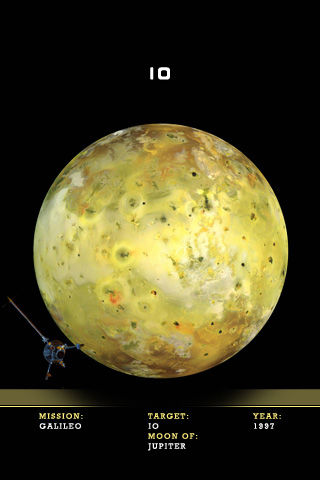 Not to re-post old material, but our iPhone planetary skins were recently posted to fuelyourcreativity.com for free download. So I thought I would just remind everyone and maybe direct a little traffic love their way.
Not to re-post old material, but our iPhone planetary skins were recently posted to fuelyourcreativity.com for free download. So I thought I would just remind everyone and maybe direct a little traffic love their way.
The iPhone Set 01: Bodies of Major Interest
 If I am going to keep making these things… I’d be a fool to not include a set for the Apple iPhone. Coincidentally, when you purchase your iPhone and do not yet have a phone service, the phone displays a full-disc image of the Earth pretty much displayed exactly as these do when uploaded to your iPhone. So in the spirit of continuity, you can now opt instead to have Mercury, Venus, Earth, The Moon (Luna), Mars, Jupiter, Io, Europa, Ganymede, Callisto, Saturn, Enceladus, Titan, Iapetus, Hyperion, Uranus, Miranda, Neptune or Triton grace your screen instead of the default Earth.
If I am going to keep making these things… I’d be a fool to not include a set for the Apple iPhone. Coincidentally, when you purchase your iPhone and do not yet have a phone service, the phone displays a full-disc image of the Earth pretty much displayed exactly as these do when uploaded to your iPhone. So in the spirit of continuity, you can now opt instead to have Mercury, Venus, Earth, The Moon (Luna), Mars, Jupiter, Io, Europa, Ganymede, Callisto, Saturn, Enceladus, Titan, Iapetus, Hyperion, Uranus, Miranda, Neptune or Triton grace your screen instead of the default Earth.
The easiest way to install wallpapers to your iPhone is to make a special set in iPhoto and simply drag all the files to that folder. Then in iTunes have your iPhone sync that folder to your photos collection. After that it is as simple as opening the “Photos” area of your iPhone. Go to your new folder of images and open whichever image you want. Then tap on the image just once and assign it as a wallpaper using the “Use as Wallpaper” button in the lower left corner of the screen.
If you have a PC I have no idea in hell how the hell you get images into your iPhone. I would buy a Mac… you have an iPhone and use iTunes… you are half-way there.
For a version of these with no graphics see this link.
Wallpaper 2560x1600 Set 03: The Planets
The planets – the complete set for collectors! While there are literally thousands of images of the planets to choose from… full globe high resolution images are actually fairly rare. They usually require many exposures to be stitched together to make one large complete image. This is not only difficult to work out across the great distances of space, but also soaks up a large amount of valuable spacecraft time and energy. This set represents the best available images of each planet in our Solar System.
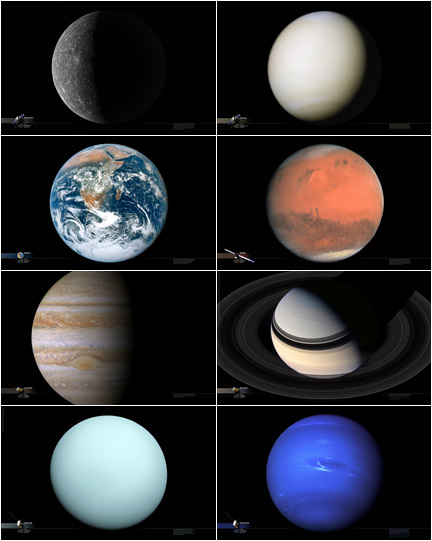
Sorry, no Pluto for more than one reason.
Wallpaper: Neptune Portrait
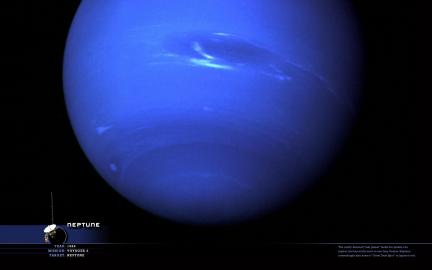 Neptune is the newly designated last “planet” in the solar system. It is the fourth gas giant and like Jupiter, it has its own “Great Red Spot” only in the case of Neptune it has been referred to as the “Great Dark Spot”. Like the other giants it also has a tenuous ring system and a system of moons. Only one of those moons, Triton, stands apart in size and characteristics and is one of the more interesting places to see in the solar system.
Neptune is the newly designated last “planet” in the solar system. It is the fourth gas giant and like Jupiter, it has its own “Great Red Spot” only in the case of Neptune it has been referred to as the “Great Dark Spot”. Like the other giants it also has a tenuous ring system and a system of moons. Only one of those moons, Triton, stands apart in size and characteristics and is one of the more interesting places to see in the solar system.


